Canon ES8600 Instruction Manual
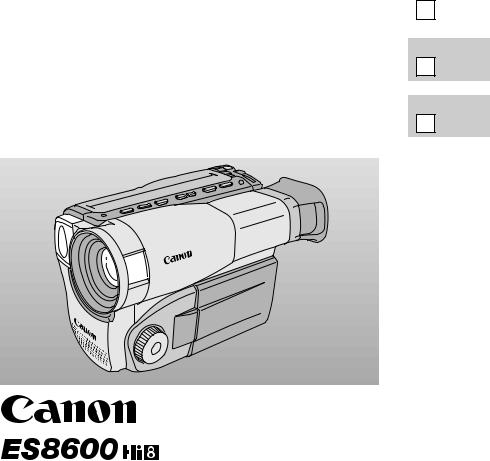
8mm VIDEO CAMCORDER |
|
|
|
|
ENGLISH |
||||
Instruction Manual |
||||
|
E |
|
||
CAMESCOPE ET LECTEUR VIDEO 8 mm |
FRANÇAIS |
|||
|
||||
Mode d’emploi
F
VIDEOCAMARA Y GRABADORA DE VIDEO 8mm |
ESPAÑOL |
|
Manual de instrucciones
Es
NTSC
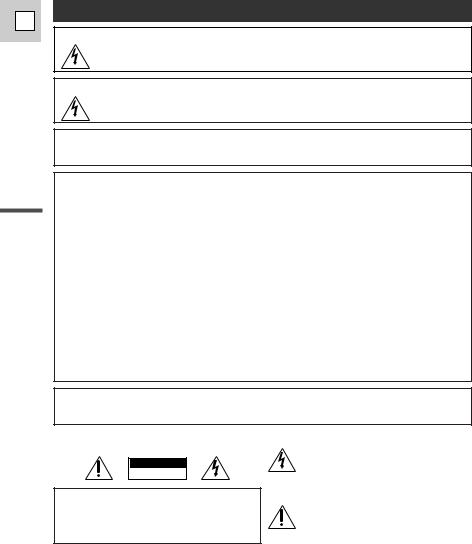
E
Introduction
Important Usage Instructions
WARNING:
TO REDUCE THE RISK OF FIRE OR ELECTRIC SHOCK, DO NOT EXPOSE THIS PRODUCT TO RAIN OR MOISTURE.
WARNING:
TO REDUCE THE RISK OF ELECTRIC SHOCK AND TO REDUCE ANNOYING INTERFERENCE, USE THE RECOMMENDED ACCESSORIES ONLY.
COPYRIGHT WARNING:
Unauthorized recording of copyrighted materials may infringe on the rights of copyright owners and be contrary to copyright laws.
8mm Video Camcorder, ES8600A
This device complies with Part 15 of the FCC Rules. Operation is subject to the following two conditions: (1) This device may not cause harmful interference, and (2) this device must accept any interference received, including interference that may cause undesired operation.
Note: This equipment has been tested and found to comply with the limits for class B digital device, pursuant to Part 15 of the FCC Rules. These limits are designed to provide reasonable protection against harmful interference in a residential installation. This equipment generates, uses and can radiate radio frequency energy and, if not installed and use in accordance with the instructions, may cause harmful interference to radio communications. However, there is no guarantee that interference will not occur in a particular installation. If this equipment does cause harmful interference to radio or television reception, which can be determined by turning the equipment off and on, the user is encouraged to try to correct the interference by one or more of the following measures:
•Reorient or relocate the receiving antenna.
•Increase the separation between the equipment and receiver.
•Connect the equipment into an outlet on a circuit different from that to which the receiver is connected.
•Consult the dealer or an experienced radio/TV technician for help.
Do not make any changes or modifications to the equipment unless otherwise specified in the manual.
If such changes or modifications should be made, you could be required to stop operation of the equipment.
Canon U.S.A. Inc.
One Canon Plaza, Lake Success, NY 11042, U.S.A.
Tel No. (516)328-5600
CAUTION:
TO PREVENT ELECTRIC SHOCK, MATCH WIDE BLADE OF PLUG TO WIDE SLOT, FULLY INSERT.
Important Warning
CAUTION
RISK OF ELECTRIC SHOCK
DO NOT OPEN
CAUTION:
TO REDUCE THE RISK OF ELECTRIC SHOCK, DO NOT REMOVE COVER (OR BACK). NO USER SERVICEABLE PARTS INSIDE. REFER SERVICING TO QUALIFIED SERVICE PERSONNEL.
The lightning flash with arrowhead symbol, within an equilateral triangle, is intended to alert the user to the presence of uninsulated “dangerous voltage” within the product’s enclosure, that may be of sufficient magnitude to constitute a risk of electric shock to persons.
The exclamation point, within an equilateral triangle, is intended to alert the user to the presence of important operating and maintenance (servicing) instructions in the literature accompanying the product.
2

IMPORTANT SAFETY INSTRUCTIONS
In these safety instructions the word “product” refers to the Canon 8mm Video Camcorder ES8600A and all its accessories.
1.Read Instructions — All the safety and operating instructions should be read before the product is operated.
2.Retain Instructions — The safety and operating instructions should be retained for future reference.
3.Heed Warnings — All warnings on the product and in the operating instructions should be adhered to.
4.Follow Instructions — All operating and maintenance instructions should be followed.
5.Cleaning — Unplug this product from the wall outlet before cleaning. Do not use liquid or aerosol cleaners. The product should be cleaned only as recommended in this manual.
6.Accessories — Do not use accessories not recommended in this manual as they may be hazardous.
7.Avoid magnetic or electric fields — Do not use the camera close to TV transmitters, portable communication devices or other sources of electric or magnetic radiation. They may cause picture interference, or permanently damage the camera.
8.Water and Moisture — Hazard of electric shock — Do not use this product near water or in rainy/moist situations.
9.Placing or Moving — Do not place on an unstable cart, stand, tripod, bracket or table. The product
may fall, causing serious injury to a child or adult, and serious damage to the product.
A product and cart combination should be moved with care. Quick stops, excessive force, and uneven surfaces may cause the product and cart combination to overturn.
10.Power Sources — The CA-550KA Compact Power Adapter should be operated only from the type of power source indicated on the marking label. If you are not sure of the type of power supply to your home, consult your product dealer or local power company. Regarding other power sources such as battery power, refer to instructions in this manual.
11.Polarization — The CA-550KA Compact Power Adapter is equipped with a polarized 2-prong plug (a plug having one blade wider than the other). The 2-prong polarized plug will fit into the power outlet only one way. This is a safety feature. If you are unable to insert the plug fully into the outlet, try reversing the plug. If the plug still fails to fit, contact your electrician to replace your obsolete outlet. Do not defeat the safety purpose of the polarized plug.
12.Power Cord Protection — Power cords should be routed so that they are not likely to be walked on or pinched by items placed upon or against them. Pay particular attention to plugs and the point from which the cords exit the product.
13.Outdoor Antenna Grounding — If an outside antenna is connected to the product, be sure the antenna is grounded so as to provide some protection against voltage surges and built-up static charges. Section 810 of the National Electrical Code, ANSI/NFPA No. 70—1984, provides information with respect to proper grounding of the mast and supporting structure, grounding of the lead-in wire to an antenna discharge unit, size of grounding conductors, location of antenna discharge unit, connection to grounding electrodes, and requirements for the grounding electrode. See figure 1.
E
Introduction
3

E
|
Fig. 1 |
EXAMPLE OF ANTENNA GROUNDING AS |
|
PER NATIONAL ELECTRICAL CODE |
|
|
|
ANTENNA |
|
|
LEAD IN |
|
|
WIRE |
|
|
GROUND |
|
|
CLAMP |
|
|
ANTENNA |
|
|
DISCHARGE |
|
|
UNIT |
|
|
(NEC SECTION |
|
|
810-20) |
|
ELECTRIC |
|
|
SERVICE |
|
|
EQUIPMENT |
GROUNDING CONDUCTORS |
|
|
(NEC SECTION 810-21) |
|
|
GROUND CLAMPS |
|
|
POWER SERVICE |
|
|
GROUNDING ELECTRODE |
|
|
SYSTEM |
|
|
(NEC ART 250. PART H) |
|
NEC - NATIONAL ELECTRICAL CODE |
|
|
14. Lightning — For added protection of this product |
|
|
during a lightning storm, or when it is left |
|
|
unattended and unused for long periods of time, |
|
Introduction |
disconnect it from the wall outlet and disconnect |
|
|
|
|
the antenna. This will prevent damage to the product due to lightning and power-line surges.
15. Overloading — Do not overload wall outlets and extension cords as this can result in a risk of fire or electric shock.
16. Objects and Liquid Entry — Never push objects of any kind into this product through openings as they may touch dangerous voltage points or short out parts that could result in a fire or electric shock. Be careful not to spill liquid of any kind onto the product.
17. Servicing — Do not attempt to service this product yourself as opening or removing covers may expose you to dangerous voltage or other hazards. Refer all servicing to qualified service personnel.
18.Damage Requiring Service — Disconnect this product from the wall outlet and all power sources including battery, and refer servicing to qualified service personnel under the following conditions:
a.When the power-supply cord or plug is damaged.
b.If any liquid has been spilled onto, or objects have fallen into, the product.
c.If the product has been exposed to rain or water.
d.If the product does not operate normally even if you follow the operating instructions. Adjust only those controls that are covered by the operation instructions. Improper adjustment of other controls may result in damage and will often require extensive work by a qualified technician to restore the product to its normal operation.
e.If the product has been dropped or the cabinet has been damaged.
f.When the product exhibits a distinct change in performance. This indicates a need for service.
19.Replacement Parts — When replacement parts are required, be sure the service technician has used replacement parts that are specified by Canon or that have the same characteristics as the original part. Unauthorized substitutions may result in fire, electric shock or other hazards.
20.Safety Check — Upon completion of any service or repairs to this product, ask the service technician to perform safety checks to determine that the product is in safe operating order.
4
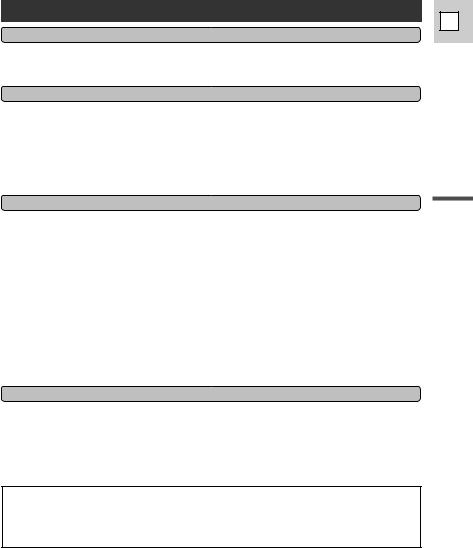
Contents
E
Introduction
Quick Overview
Advanced Functions
Introduction
Additional Information
The serial number of this product may be found on the |
Date of Purchase |
bottom of the camera. No others have the same serial |
Dealer Purchased From |
number as yours. You should record the number and |
Dealer Address |
other vital information here and retain this book as a |
Dealer Phone No. |
permanent record of your purchase to aid identification |
Model Name ES8600A |
in case of theft. |
Serial No. |
5

E
Introduction
Thank you for Choosing a Canon
First, we’d like to thank you for buying this Canon camcorder. Its advanced technology
Getting started
To get started we suggest that you master the basic operations of the camcorder first, before moving on to use its full range of features.
For quick reference (in addition to the contents and index) please refer to:
•Finding Your Way Around the ES8600 (p. 8)
•Screen displays (p. 70)
•Troubleshooting — in case you run into any problems (p. 67)
Note that capital letters are used to refer to settings that appear in the display and buttons labeled on the camcorder itself e.g. Press the EJECT 5 button.
Check that this package contains the following accessories:
BP-911K Battery Pack SS-500
Shoulder Strap
C-250 AV Cable |
Lens cap and lens cap cord |
|
(Attached to camera) |
CA-550K Compact |
Lithium button |
Power Adapter |
battery (CR2025) |
6
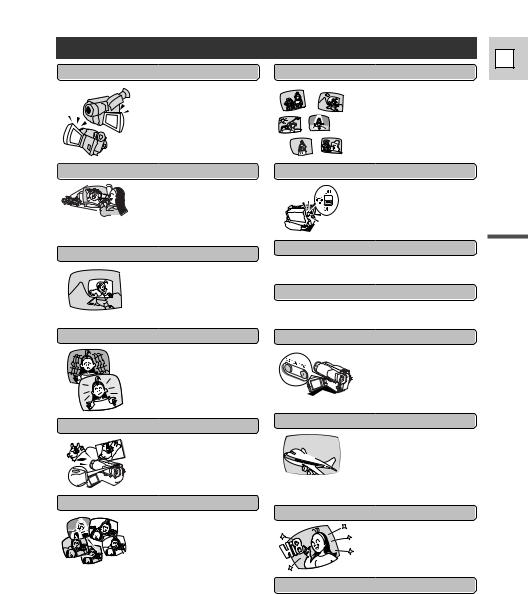
E
Powerful recording programs
AUTO FLEXIZONE
SPORTS SPOTLIGHT
Six recording programs deal with everything from simple point-and-shoot operation to the most challenging recording conditions.
Video light
Photo Mode
You can record still pictures like a photograph for approximately 7 seconds.
PHOTO

Digital effects
Advanced digital technology allows you to add special effects during recording and playback.
Time base corrector |
Introduction |
|
Lithium ion power supply |
||
|
Custom Keys
With the unique Custom Keys, you can decide which functions you want at your fingertips. Assign frequently used functions to the keys on the camera body.
Titles
You can choose from among a selection of preset titles to add to
WEDDING your recording.
Also, you can choose the color for the date and title from among 7 colors to display and record on the tape.
Hi8
Fade |
7 |
|

E
Quick Overview
Finding Your Way Around the ES8600
 EJECT button (p. 13)
EJECT button (p. 13)
C. (counter) RESET button (p. 71)
(fast forward) button (p. 22) REC SEARCH + button (p. 38)
 (rewind) button (p. 22)
(rewind) button (p. 22)  REC SEARCH – and
REC SEARCH – and
 (record review) button (p. 38)
(record review) button (p. 38)
 (play) button (p. 22) D.ZOOM button (p. 17)
(play) button (p. 22) D.ZOOM button (p. 17)
 (stop) button (p. 22) BLC button (p. 43)
(stop) button (p. 22) BLC button (p. 43)
 (pause) button (p. 22) FADE button (p. 37)
(pause) button (p. 22) FADE button (p. 37)
Lens (p.63)
Microphone
Zoom control (p. 17)
Cassette compartment (p. 13)
Audio/Video Output terminal (p. 24)
Grip belt (p. 54)
 FOCUS button (p. 42)
FOCUS button (p. 42)
SET button (p. 28)
MENU button (p. 27)
Custom key 2 (p. 29)
Custom key 1 (p. 29)
OPEN button (p. 19)
Program selector (p. 15–16, 39–40)
Video light (p. 51)
8

BATTERY RELEASE button (p. 11)
Viewfinder (p. 54, 64)
|
|
Battery pack |
|
|
(p. 11–12, 56–57) |
|
|
Manual focus dial (p. 42) |
|
|
Speaker volume dial |
|
|
(p. 23) |
|
|
Selector dial (p. 28) |
Tripod socket |
Viewfinder |
Backup battery |
(p. 25) |
focusing |
holder (p. 58) |
|
switch (p. 54) |
|
Strap attachment bar |
|
PHOTO button (p. 46) |
(p. 55) |
|
|
Video light switch |
|
STANDBY lever (p. 15) |
(p. 51) |
|
|
S-video terminal |
|
Start/stop button (p. 15) |
|
|
|
(p. 24) |
|
Strap attachment bar |
|
|
|
FlexiZone controller |
|
(p. 55) |
|
|
|
(p. 41–44) |
|
DC IN terminal (p. 10) |
|
|
|
CHARGE indicator |
|
|
(p. 11) |
|
|
E
Overview Quick
9
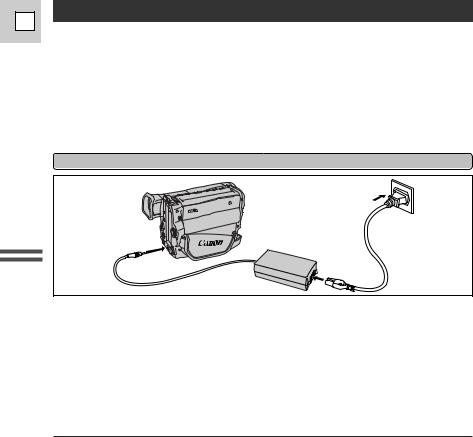
E
Quick Overview
Powering Your Camcorder
Before operating your camera, you will need to use the power adapter to:
Provide power from an AC outlet or
Charge a battery pack
Notes:
•The power adapter converts current from a household power socket (100–240 V AC, 50/60 Hz) to the DC current used by your camera.
•If the adapter is used next to a TV, it may cause noise bars to appear on the TV— move the adapter away from the TV or the antenna cable.
Connecting the camera to an AC outlet
3
2
1
Use the power adapter to provide your camera with instant power from an AC outlet.
1.Connect the AC cable to the power adapter.
2.Connect the power adapter to the camera’s DC IN terminal.
3.Connect the power adapter to an AC outlet.
4.Remove the power adapter after use.
•Always turn the camera off before connecting/removing the power source.
•For the power adapter, use only Canon CA-550K (or CA-550). Do not use other equipment.
CA-550K Compact power adapter
Specifications
Power supply |
100–240 V AC, 50/60 Hz |
Power consumption |
20 W |
|
|
Rated output |
8.4 V, 1.5 A DC |
|
|
Operating temperature range |
32˚–104˚F (0˚–40˚C) |
Dimensions |
4.1 × 1.2 × 2.2 in (105 × 30 × 56 mm) |
Weight |
9.7 oz (275 g) |
Weight and dimensions are approximate. Errors and omissions excepted.
Subject to change without notice.
10
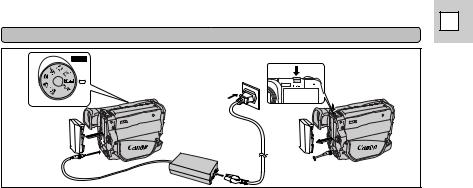
E
Charging and attaching the battery pack
POWER |
6 |
4 |
3 |
2 |
Your battery pack was partially charged before it left the factory. It should have enough power for you to check that your camera is working properly. However, you must charge the battery pack fully if you want it to power the camera for more than a few minutes.
1. |
Set the program selector to OFF before you charge the battery pack. |
|
|
|
|||
2. |
Connect the power adapter to the camera’s DC IN terminal. |
Quick |
|
3. |
Attach the battery pack to the camera. |
||
|
|||
|
• Align the triangle on the battery pack with the line on the camera. Slide the battery in the |
Overview |
|
|
direction of the arrow until it clicks into place. |
||
|
|
||
4. |
Plug the adapter into an AC outlet. |
|
|
|
• The charge indicator flashes to show that charging is in progress. Single flashes mean that |
|
|
|
the battery pack is less than 50% charged. Double flashes mean that it is between 50% |
|
|
|
and 75% charged. Triple flashes mean that it is more than 75% charged. The indicator |
|
|
|
glows steadily when the battery pack is fully charged. |
|
|
5. |
When charging is complete, disconnect the power adapter. |
|
|
6. |
Detach the battery pack after use. |
|
|
|
• Press and hold the BATTERY RELEASE button while you slide the battery off the camera. |
|
|
|
• Always turn the camera off before removing the power source. |
|
Note:
•You can find detailed notes for using the batteries in the “Notes on Using the Batteries” on p. 56. These notes include charging and recording times and how to install the backup battery.
11
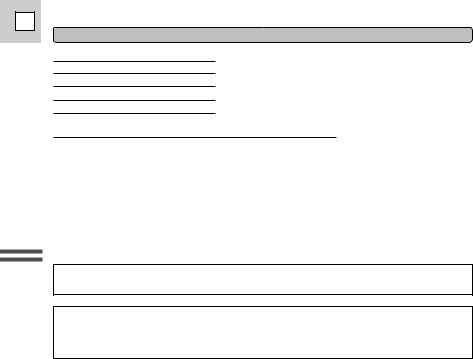
E
Quick Overview
Charging and recording times
Continuous recording time : (video light off) *
|
(Using LCD screen) |
(Using viewfinder) |
||
BP-911K (supplied) |
1 hr. |
30 min. |
2 hrs. |
5 min. |
BP-915 (optional) |
1 hr. |
35 min. |
2 hrs. |
5 min. |
|
|
|
||
BP-930 (optional) |
3 hrs. 15 min. |
4 hrs. 15 min. |
||
BP-945 (optional) |
4 hrs. 55 min. |
6 hrs. 25 min. |
||
*Continuous recording time will be reduced by approx. 50% with continued use of the video light.
•These times vary — the safest policy is always to have 2 or 3 times as many battery packs as you think you will need.
When the replacement of power supply is required, please return it to the responsible nearest Canon Service Center, and please replace it with the power adapter CA-550.
•The adapter can be used with a power supply between 100 and 240 V AC. Contact your Canon dealer for information about plug adapter for overseas use.
For U.S.A customers only: For areas where 120 V AC power is not used, you will need a special plug adapter.
12

Loading a Cassette
E
2 |
3 |
4 |
 EJECT
EJECT
Use video cassettes marked with an f or g.
After loading a cassette, use record search (p. 38) to find the point where you want to start recording.
Loading and unloading
1. |
Make sure that you have attached or connected a power source. |
Quick |
|
2. |
Press the 5 EJECT button and wait for the cassette compartment to open. |
||
|
|||
3. |
Load/unload the cassette. |
Overview |
|
4. |
Press the P mark on the compartment until it clicks, and wait for it to close. |
• Insert the cassette gently with the window facing out.
• Remove the cassette by pulling it straight out.
• Never push down the top of the compartment.
Protecting tapes from accidental erasure
REC |
ERASE |
REC |
ERASE |
|
OFF ON |
OFF ON |
|||
|
|
|||
SAVE |
|
SAVE |
|
To protect your recordings from accidental erasure, slide the red switch on the cassette so that it covers the hole. (This switch position is usually labeled SAVE or ERASE OFF.) If you load this cassette and power on the camera, “v” flashes in the display.
If you want to record on the cassette again, slide the red switch back so the hole is open. (This position is usually labeled REC or ERASE ON.)
13

E
Handling cassettes
•To protect the tape heads, transfer cassettes directly from the tape case to the camcorder – do not open the tape protect cover or touch the tape itself.
•Do not use cassettes where the tape has been damaged or rejoined – they may damage the camcorder.
•Do not insert anything into the small holes on the cassette or cover them with cellophane tape.
•Handle cassettes with care – dropping them or exposing them to external shocks may cause internal damage.
•Store cassettes in the provided case, rewinding them to the start of the tape first, and then storing them upright.
About Hi8
Quick Overview
14
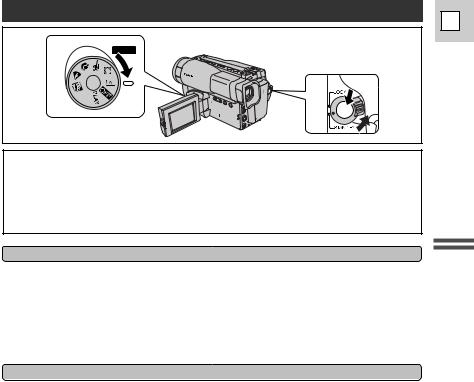
Basic Recording
1
2,3
Safe cassette operation
When you turn the power off or remove the power source, be sure to set the camcorder first to record pause, stop or still pause mode.
Turning the power off or removing the power source while the tape is moving (during recording, play, rewind for example), will make the counter display appear wrong or may cause tape damage.
Before you start recording
Have you completed the following steps?
•Attach a power source (p. 10).
•Load a cassette (p. 13).
•Adjusted the LCD screen (p. 19) or viewfinder, fastened the grip belt and taken off the lens cap (p. 54).
You may also want to install the backup battery (p. 58) in order to set date and time display (p. 32).
To record
1.Turn the program selector to the a position.
•This selects the camera’s Automatic recording program. It allows you to simply point and shoot without making any manual adjustments.
2.Turn the STANDBY lever to STANDBY.
•PAUSE appears in the display — the camera is now in “record pause mode.”
3.Press the start/stop button to begin recording.
•REC appears in the display.
4.Press the start/stop button again to pause recording.
•The camera returns to record pause mode and PAUSE reappears in the display.
•You can stop and restart recording as often as you like by pressing the start/stop button.
•The camera will turn itself off if you leave it in record pause mode for more than about 5 minutes. To return to record pause mode, turn the STANDBY lever to LOCK and back to STANDBY, or set the program selector to OFF and then back to camera mode.
E
Overview Quick
15

E
Quick Overview
When you have finished recording
•Replace the lens cap.
•Unload the cassette.
•Return the viewfinder to its lowered position.
•Close the LCD panel.
•Set the program selector to OFF.
•Disconnect the power source.
Notes:
•To check that the camera is recording correctly, be sure to make a test recording first.
•Before making important recordings, clean the video heads using Canon CC-8 Video Head Cleaning Cassette or a commercially available dry-type head cleaning cassette.
•For tips on how to make better videos, see page 25.
Recording with the LCD screen
In place of using the viewfinder, you can also monitor recording using the LCD screen. When you open the LCD panel, the viewfinder turns off automatically.
For more details please refer to “Using the LCD Screen” (p. 19).
Notes:
•You cannot monitor the sound from the speaker during recording.
•The LCD screen uses more power than the viewfinder, so possible recording time will be less than if you were to use the viewfinder.
•Be sure to close the LCD panel flush to the camera body when you have finished recording with the LCD screen.
Demonstration
 DEMONSTRATION...ON
DEMONSTRATION...ON
(see p. 27)
16

Zooming |
|
|
Zoom in |
W |
T |
|
|
|
Zoom out |
The camera’s 22× zoom lens allows you to choose the best picture angle for each scene:
•Turn the zoom control towards W to zoom out to wide-angle.
•Turn it towards T to zoom in to telephoto.
You can also control the speed of zooming:
•Move the control slightly to zoom slowly.
•Turn it farther to zoom more quickly. (The farther you turn the zoom control, the faster the zoom speed.)
Turning the 800× digital zoom on/off
Turn the digital zoom on/off by pressing the D.ZOOM button, to magnify the camera’s zoom range by more than 22×.
• In addition, you can assign CUSTOM KEY 1 to turn the digital zoom on/off (see p. 29).
The zoom control continues to work as usual. You can freely zoom in and out between 1× and 800× magnification — the camera automatically switches between optical zooming (up to 22×) and digital zooming (22× to 800×).
Note:
•When you enter the digital zoom range in FlexiZone mode, the FlexiZone frame becomes locked in the center of the display.
E
Overview Quick
17
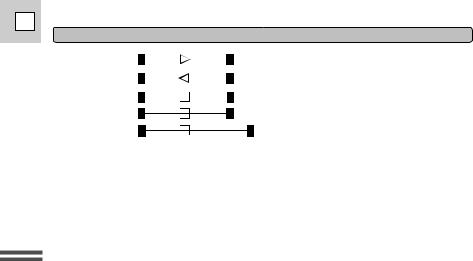
E
Zoom displays
|
|
|
|
|
|
|
|
|
|
|
Zoom in |
W |
|
|
|
|
|
T |
|
|
|
|
|
|
|
|
||||||
Zoom out |
|
|
|
|
|
|
|
|
|
|
W |
|
|
|
|
|
T |
|
|
|
|
|
|
|
|
|
||||||
Stationary |
|
|
|
|
|
|
|
|
|
|
W |
|
|
|
|
|
T |
|
|
|
|
|
|
|
|
|
|
|||||
|
|
|
|
|
|
|
|
|
||
Optical zoom |
W |
|
|
|
|
|
T |
|
|
|
|
|
|
|
|
|
|
|
|
|
|
Digital zoom |
W |
|
|
|
|
|
800× |
T |
|
|
|
|
|
|
|
|
|
||||
|
|
|
|
|
|
|
|
|||
|
|
|
|
|
|
|
|
|
|
|
Quick Overview
18
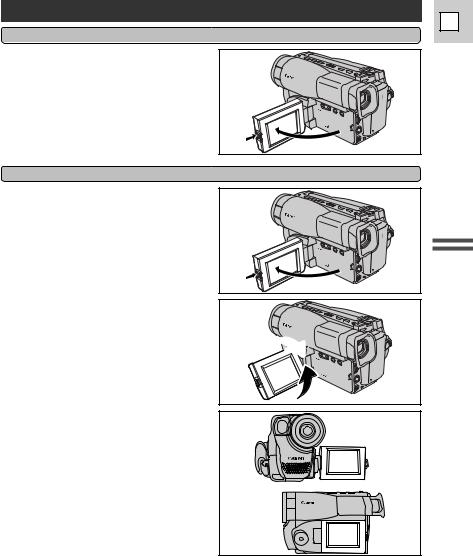
Using the LCD Screen
Open the LCD screen
Changing the angle of the LCD screen
90°
90°
 180°
180°
E
Overview Quick
19
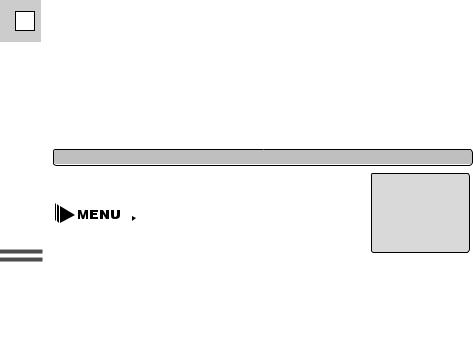
E
Notes:
•Avoid touching the LCD screen when moving the LCD panel.
•Do not hold the camera by the LCD panel or the viewfinder.
•Make sure you open the LCD panel at 90°, before attempting to rotate it backwards or forwards.
•Always rotate the LCD panel vertically into place, before closing it or pushing it flat against the side of the camera.
•Be careful not to leave the LCD, viewfinder or lens exposed to direct sunlight outdoors or in a window. Doing so could cause damage.
•Bright light falling on the LCD screen may cause glare that makes it difficult to view the image. In this case, switch to using the viewfinder. You are also able to adjust the brightness of the screen (see “Adjusting the LCD screen” below).
Adjusting the LCD screen
(see p. 27) |
LCD PICTURE ADJUST |
|
|
||
|
|
BRIGHTNESS |
|
||
|
|
– |
<<<<<<<< |
|
+ |
Quick Overview
Notes:
•The camera will remember your adjustment settings even after you turn it off.
•The adjustments of the LCD do not effect the recorded images or the viewfinder.
About the LCD Screen
The LCD screen built into this camcorder is a high precision product.
However, small black dots or bright points of light (red, blue or green) may appear constantly on the LCD screen. This is not a malfunction of the LCD screen and they are not recorded on the tape. (Effective dots: more than 99.99%)
20

E
Allowing the subject to monitor recording
When you turn the LCD panel so that it faces the opposite direction (see diagram below), you can watch yourself during recording or let your subject monitor recording.
1.Open the LCD panel (p. 19).
2.Rotate the LCD panel 180° until the screen faces the same direction as the lens.
•The viewfinder is also activated when the LCD is in this position.
Note:
1
2
Overview Quick
• Screen displays are reversed, but titles/dates are correctly recorded.
21

E
Quick Overview
Playing Back a Cassette
POWER
FADE |
BLC D.ZOOM |
REC SEARCH |
Safe cassette operation
When you turn the power off or remove the power source, be sure to set the camcorder first to record pause, stop or still pause mode.
Turning the power off or removing the power source while the tape is moving (during recording, play, rewind for example), will make the counter display appear wrong or may cause tape damage.
You can use the LCD screen for instant, on-the-spot playback. The camera also plays back the sound track via the built-in speaker (p. 23).
To play back your recordings on a TV, see p. 24.
1.Attach a power source and turn the program selector to PLAY.
2.Load the cassette.
3.Press the e button to start playback.
•To end playback, press the 3 button.
•To wind the tape forwards, stop playback and press the 1 (fast forward) button.
•To wind the tape backwards, stop playback and press the ` (rewind) button.
•If the playback picture is rough, clean the video heads using a Canon CC-8 Video Head Cleaning Cassette or a commercially available dry-type head cleaning cassette.
Special playback
Still playback
To view the video as a still picture press the a button. To resume normal playback, press it again, or press the e button. The camera automatically goes into stop mode after about 5 minutes’ playback pause.
Fast forward playback
To play back the recording at about 9 times normal speed, press and hold the 1 button during normal playback.
22

E
Rewind playback
For reverse playback at about 7 times normal speed, press and hold the ` button during normal playback.
High-speed search
To play back the recording at about 19 times normal speed, press and hold the 1 button during normal fast forward. For reverse playback at about 19 times normal speed, press and hold the ` button during normal rewind.
Notes:
•When the tape reaches the end during normal playback it rewinds automatically.
•Noise bars appear and the soundtrack cannot be heard during special playback. The picture may roll and divide, appear black and white and the picture may not be visible during high-speed search.
•During still playback, the picture flickers, and fast action scenes may appear blurred.
•The tape counter is reset when a cassette is loaded.
•When you playback a cassette suffered considerable vibration or shaking during recording, you may find that the playback picture is not stable, depending on the TV you use.
Built-in speaker
Overview Quick
23
